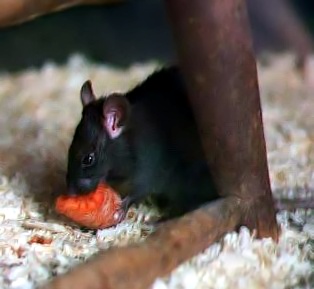Difference between revisions of "AY Honors/Species Account/Rattus rattus"
JadeDragon (talk | contribs) (create page) |
JadeDragon (talk | contribs) |
||
| Line 5: | Line 5: | ||
|description=common long-tailed rodent of the genus Rattus (rats) in the subfamily Murinae (murine rodents). The species originated in tropical Asia and spread through the Near East in Roman times before reaching Europe by the 1st century and spreading with Europeans across the world. | |description=common long-tailed rodent of the genus Rattus (rats) in the subfamily Murinae (murine rodents). The species originated in tropical Asia and spread through the Near East in Roman times before reaching Europe by the 1st century and spreading with Europeans across the world. | ||
Black rats are generalist omnivores. They are serious pests in nature as they eat birds and insects, and to farmers as they eat a wide range of agricultural crops. They are vectors of many diseases including the bacterium Yersinia pestis, an agent of bubonic plague. | Black rats are generalist omnivores. They are serious pests in nature as they eat birds and insects, and to farmers as they eat a wide range of agricultural crops. They are vectors of many diseases including the bacterium Yersinia pestis, an agent of bubonic plague. | ||
| − | + | habitat=everywhere they can get a foothold | |
| − | + | type of sexual reproduction=breed like other mammals | |
| − | + | eating habits=Black rats express great flexibility in their foraging behavior. They are predatory animals and adapt to different micro-habitats. They often meet and forage together in close proximity within and between sexes. Rats tend to forage after sunset. If the food cannot be eaten quickly, they will search for a place to carry and hoard to eat at a later time. Although black rats eat a broad range of foods, they are highly selective feeders; only a restricted number of the foods they eat are dominant foods. When black rat populations are presented with a wide diversity of foods, they eat only a small sample of each of the available foods. This allows them to monitor the quality of foods that are present year round, such as leaves, as well as seasonal foods, such as herbs and insects. This method of operating on a set of foraging standards ultimately determines the final composition of their meals. Also, by sampling the available food in an area, the rats maintain a dynamic food supply, balance their nutrient intake, and avoid intoxication by secondary compounds. | |
| − | + | Diseases and harm to humans=when introduced to a new area, black rats often destroy native vegetation and can cause native species of other animals and birds to go extinct. Black rats are able to carry a number of pathogens, of which bubonic plague (via the rat flea), typhus, Weil's disease, toxoplasmosis and trichinosis are the best known. Rats also eat food stores and destroy other property. | |
| − | + | Prevention=municipal sanitation and pest control measures are widely practiced to control the rat population. This includes poisons and traps. Pesticides are sprayed from planes when attempts are made to kill of rats on islands. When efforts are let up, the rat population often rebounds within months. | |
}} | }} | ||
Revision as of 08:13, 16 October 2014
black rat (Rattus rattus)
Description: common long-tailed rodent of the genus Rattus (rats) in the subfamily Murinae (murine rodents). The species originated in tropical Asia and spread through the Near East in Roman times before reaching Europe by the 1st century and spreading with Europeans across the world. Black rats are generalist omnivores. They are serious pests in nature as they eat birds and insects, and to farmers as they eat a wide range of agricultural crops. They are vectors of many diseases including the bacterium Yersinia pestis, an agent of bubonic plague. habitat=everywhere they can get a foothold type of sexual reproduction=breed like other mammals eating habits=Black rats express great flexibility in their foraging behavior. They are predatory animals and adapt to different micro-habitats. They often meet and forage together in close proximity within and between sexes. Rats tend to forage after sunset. If the food cannot be eaten quickly, they will search for a place to carry and hoard to eat at a later time. Although black rats eat a broad range of foods, they are highly selective feeders; only a restricted number of the foods they eat are dominant foods. When black rat populations are presented with a wide diversity of foods, they eat only a small sample of each of the available foods. This allows them to monitor the quality of foods that are present year round, such as leaves, as well as seasonal foods, such as herbs and insects. This method of operating on a set of foraging standards ultimately determines the final composition of their meals. Also, by sampling the available food in an area, the rats maintain a dynamic food supply, balance their nutrient intake, and avoid intoxication by secondary compounds. Diseases and harm to humans=when introduced to a new area, black rats often destroy native vegetation and can cause native species of other animals and birds to go extinct. Black rats are able to carry a number of pathogens, of which bubonic plague (via the rat flea), typhus, Weil's disease, toxoplasmosis and trichinosis are the best known. Rats also eat food stores and destroy other property. Prevention=municipal sanitation and pest control measures are widely practiced to control the rat population. This includes poisons and traps. Pesticides are sprayed from planes when attempts are made to kill of rats on islands. When efforts are let up, the rat population often rebounds within months.

